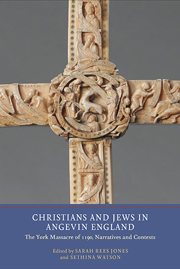Book contents
- Frontmatter
- Contents
- List of Illustrations
- Contributors
- Editor's Preface and Acknowledgments
- Abbreviations
- Introduction: The Moment and Memory of the York Massacre of 1190
- Part I The Events of March 1190
- Part II Jews among Christians in Medieval England
- Part III Representations
- Afterword: Violence, Memory and the Traumatic Middle Ages
- Bibliography
- Index
- York Medieval Press: Publications
Introduction: The Moment and Memory of the York Massacre of 1190
Published online by Cambridge University Press: 05 May 2013
- Frontmatter
- Contents
- List of Illustrations
- Contributors
- Editor's Preface and Acknowledgments
- Abbreviations
- Introduction: The Moment and Memory of the York Massacre of 1190
- Part I The Events of March 1190
- Part II Jews among Christians in Medieval England
- Part III Representations
- Afterword: Violence, Memory and the Traumatic Middle Ages
- Bibliography
- Index
- York Medieval Press: Publications
Summary
During the course of one desperate night in March 1190, an estimated 150 Jewish men, women and children committed suicide or were murdered at the royal castle in York, where they had fled for safety. The York massacre horrified contemporaries, Christians and Jews, and is remembered today around the world. It is recalled in Jewish elegies and holds a singular, sad place in the English national story as ‘the most notorious anti-Jewish atrocity’ in its history. Most particularly, the memory is tied to place. Clifford's Tower, the mid-thirteenth-century stone keep of the royal castle, has become its most enduring symbol. Yet it is the city itself that is most profoundly identified with the massacre. Report ascribed a medieval ‘Herem’ (ban) to the city, that from that awful night no Jewish person should stay within its walls. In fact, a medieval Jewish population returned to and for a short while flourished at York and a modern congregation emerged in the late nineteenth century. The rumour was less a response to historical circumstance than to the city's perceived silence, which was interpreted as a refusal to remember. This silence was broken in 1978 when the memorial plaque was unveiled at Clifford's Tower by leaders of the city and England's Jewish and Christian communities. In the following years York's Jewish past was more fully recovered through archaeological excavation of its Jewish cemetery, a four-day commemoration of the massacre's octocentenary, and revised guidebooks to Clifford's Tower.
- Type
- Chapter
- Information
- Christians and Jews in Angevin EnglandThe York Massacre of 1190, Narratives and Contexts, pp. 1 - 14Publisher: Boydell & BrewerPrint publication year: 2013



